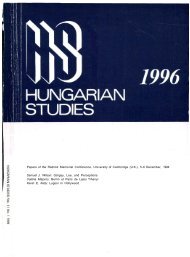The Canadian-American Review of Hungarian Studies - Vol. 4 ... - EPA
The Canadian-American Review of Hungarian Studies - Vol. 4 ... - EPA
The Canadian-American Review of Hungarian Studies - Vol. 4 ... - EPA
You also want an ePaper? Increase the reach of your titles
YUMPU automatically turns print PDFs into web optimized ePapers that Google loves.
the vast majority <strong>of</strong> <strong>Canadian</strong>s. <strong>The</strong> postwar decades also witnessed thegradual decline <strong>of</strong> nativistic antagonisms against immigrant ethnicgroups. At long last, "New <strong>Canadian</strong>s" could enjoy a greater share <strong>of</strong>the wealth, and a greater degree <strong>of</strong> security that their new homeland hadto <strong>of</strong>fer.<strong>The</strong> Magyars inCanada<strong>The</strong> first small groups <strong>of</strong> <strong>Hungarian</strong>s arrived in Canada in the secondhalf <strong>of</strong> the 1880's, but it was not until the turn <strong>of</strong> the century that theybegan to migrate to this country in significant numbers. According tothe very unreliable statistics <strong>of</strong> the 1911 census, there were 11,648 <strong>of</strong>them in Canada that year. 5 <strong>The</strong> First World War stopped their influx,but the gates were opened again during the 1920's. Between 1924 and1930, a veritable flood <strong>of</strong> Magyars came to Canada, especially to theprairie provinces, driven by a mixture <strong>of</strong> political and economic considerations.Following the Great War, the peacemakers dismemberedhistoric Hungary. <strong>The</strong> economic situation <strong>of</strong> truncated Hungary wasvery weak. She had some industries but very little in the way <strong>of</strong> mineraland energy resources; and she had much agricultural land but fewmarkets for produce. But worst <strong>of</strong>f were those Magyars whose homeswere transferred to the successor states: Czechoslovakia, Yugoslavia,and an enlarged Romania. Hungary could absorb only a few <strong>of</strong> theseunfortunate Magyars. <strong>The</strong> United States, the traditional recipient <strong>of</strong><strong>Hungarian</strong> immigrants prior to 1914, virtually closed its gates to EastEuropean migration after the war. Canada remained one <strong>of</strong> the fewcountries to admit <strong>Hungarian</strong>s.<strong>The</strong> victims <strong>of</strong> the postwar dislocations in central Eastern Europebegan arriving in Canada in the mid-1920's. Although many <strong>of</strong> thesenewcomers were really political refugees, they were not admitted assuch. <strong>The</strong>y came as agricultural labourers, even though some <strong>of</strong> themhad been craftsmen, landowners and members <strong>of</strong> the pr<strong>of</strong>essions.Along with these refugees from the successor states came many poorpeasants and landless farm workers who left impoverished Hungarymainly for economic reasons.During the Great Depression, Canada's gates were once more shut tolarge-scale immigration; but return to normalcy after the Second WorldWar meant that the country could again admit a great number <strong>of</strong>immigrants. In this period <strong>Hungarian</strong>s came in two distinct waves. Atthe end <strong>of</strong> the 1940's, the so-called "displaced persons" arrived. <strong>The</strong>ywere political exiles <strong>of</strong> the war and <strong>of</strong> its immediate aftermath. Less
















